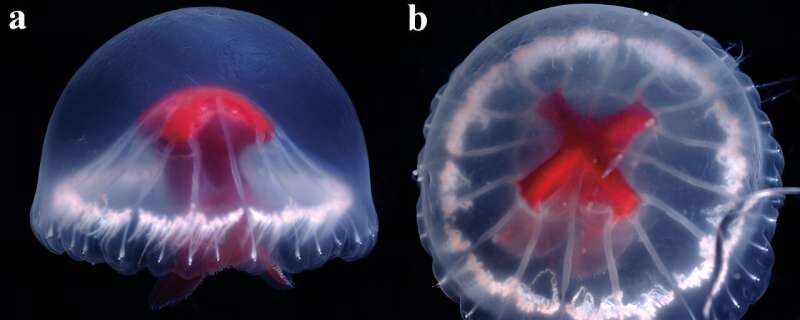This article has been reviewed according to Science X's editorial process and policies. Editors have highlighted the following attributes while ensuring the content's credibility:
fact-checked
trusted source
proofread
Researchers describe a novel species of jellyfish discovered in a remote location in Japan

A research team has published a description of a rare medusa found at a depth of 812 meters. The animal has been sighted only twice in a deep-sea volcanic structure called Sumisu Caldera, in the Ogasawara Islands. The gelatinous animal with a diameter of about 10 cm and a red stomach resembling the Cross of St. George when seen from above is Santjordia pagesi, a newly described species of medusa. Medusae are a type of free-swimming, umbrella-shaped jellyfish with a reduced stalk.
The new species is reported in an article published in the journal Zootaxa.
André Morandini, last author of the article, was part of the research team. He is a professor of zoology at the University of São Paulo's Institute of Biosciences (IB-USP) and Director of the Center for Marine Biology (CEBIMar) at the same university. The other authors are researchers at the Japan Agency for Marine-Earth Science and Technology (JAMSTEC), in Japan, and the Okinawa Institute of Science and Technology (OIST), also in Japan.
The St. George's Cross Medusa, as it has been named, apparently lives only in the Sumisu Caldera in Ogasawara Islands, some 460 km south of Tokyo. The caldera is a hydrothermally active deep-sea volcanic structure with a diameter of about 10 km and a depth of 812 m.
"The species is very different from all the deep-sea medusae discovered to date. It's relatively small, whereas others in this kind of environment are much larger. The bright red coloring of its stomach probably has to do with capturing food," Morandini explained.
Like all jellyfish, S. pagesi is transparent, and the bright red stomach ensures that bioluminescent organisms cannot be seen by predators after they are swallowed. Bioluminescence (emission of light by living organisms) is common in the darkness of the deep sea.
The species epithet pagesi was chosen to honor Dr. Francesc Pagès, a jellyfish taxonomist from Barcelona who died recently. The authors determined that the medusa belongs to a new genus (Santjordia, St. George in Catalan) and subfamily (Santjordiinae) in the jellyfish family Ulmaridae.

Rare and inaccessible
Discovery of a new species usually entails the collection of several specimens, but S. pagesi is very rare, and it was so hard to collect that the description was based on a single specimen, although the scientists did see another nearby and expect future surveys of the deep ocean to discover more members of the group.
The specimen was captured in 2002 by the Remotely Operated Vehicle (ROV) Hyperdolphin during a dive in the Sumisu Caldera, which can only be accessed by scientific expeditions with this type of special equipment. No other specimens were found until 2020, when the KM-ROV filmed, but was unable to collect, another individual of the same species.
"We opted to publish the description and call attention to the species that are present at the site, which has a substrate rich in minerals and the potential to be commercially developed. Unfortunately, research can't be conducted in such places without partners who have interests of this kind," Morandini said.
Because it is so different even from closely related species, the researchers believe S. pagesi may have an arsenal of venoms that are also unlike those discovered to date.
"Who knows? Maybe it holds secrets more valuable than all the mineral wealth that could be extracted from that place. All this with the advantage of keeping the species and the site intact," Morandini said.
More information: DHUGAL JOHN LINDSAY et al, A new subfamily of ulmarid scyphomedusae, the Santjordiinae, with a description of Santjordia pagesi gen. et sp. nov. (Cnidaria: Scyphozoa: Discomedusae: Semaeostomeae: Ulmaridae) from the Sumisu Caldera, Ogasawara Islands, Japan, Zootaxa (2023). DOI: 10.11646/zootaxa.5374.4.5
Provided by FAPESP



















